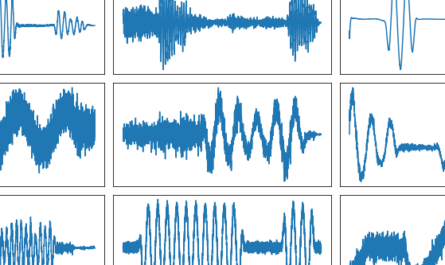RF signal classification deals with the task of analyzing unknown signals. The goal is to automatically classify the unknown signal into some predefined categories. In recent years, machine learning techniques became more and more and popular for these classification problems with very promising results.
In general, the term RF (or radio) signal classification is somehow a generic term. Different flavors of radio signal classification are known, that basically differ in the types of classes used. This articles introduces the tree typical signal classification tasks: automatic modulation classification, signal identification and RF fingerprinting.
Automatic Modulation Classification (AMC)
The goal of automatic modulation classification (AMC) (also called modulation recognition, “modrec”) is to the determine the modulation type of a signal. In this context “modulation” refers to the basic “textbook” modulation types. Some commonly used examples are phase-shift keying (PSK, QPSK, 8-PSK), quadrature amplitude modulation (e.g. 16-QAM, 64-QAM, 256-QAM), frequency shift keying (FSK, M-FSK) or OFDM. It may also include analog modulations, such as amplitude modulation (AM), single-sideband voice and many more.
AMC can have different granularity with respect to the classes. Some simple systems may be able to distinguish modulations only coarsely, e.g. between PSK, FSK and QAM. More advanced systems may be able to detect more modulation types, like BPSK, QPSK, 8-PSK, 16-QAM, 64-QAM, etc. Highly sophisticated systems may support a large number of different modulation types. IN addition, they may be able distinguish between highly similar modulations, such as 2-FSK, 2-GFSK (gaussian FSK), MSK (minimum-shift keying) and GMSK (gaussian MSK).
Automatic modulation classification outputs only the bare modulation type and does not identify RF signals. In order to identify a signal, other parameters need to be taken into account, like the baud rate, envelope, framing and number of carriers.

Automatic RF Signal Identification
RF signal identification (also called wireless standard identification or recognition) is the task of identifying the type or transmission standard of the signal. The term “standard” refers to standardized transmission waveforms. In ham radio operation this is often referred to as “mode”.
The type of present signal classes highly depends on the frequency band of operation. In the UHF or VHF band the types may be FM radio, 4G, 5G, WiFi, digital TV, GPS, etc. For the shortwave band (3 – 30 MHz) different modes are encountered, like AM broadcast, SSB voice, Morse code, Stanag 4285, etc. Especially in the shortwave band many different types of signals can be found and the number of classes can be high. This makes automatic signal identifaction a challenging task.

Specific Emitter Identification (SEI)
Specific emitter identification (SEI), also called RF fingerprinting (RFF), is the task of identifying the transmitter from which a signal has been sent. This is possible, because every transmitter unintentionally imposes some small characteristic changes on the transmitted waveform. These small variations in the signal waveform may originate from analog electronics, such as modulators, filters or power amplifiers. To some extent also the exact implementation of the (digital) waveform generation can play a major role in distinguishing different transmitters.
SEI is often used in military applications, but also in civil applications, e.g. for device identification in the domain of internet-of-things (IoT) and for navigational purposes.

Applications of RF Signal Classification
Cognitive Radio
Cognitive radio is a new concept, where the radio transceiver continuously senses the spectrum and adapts the transmission to it. While a traditional transceiver often operates at a fixed frequency, modulation, bandwidth and power, cognitive radio are very flexible and can quickly change these parameters.
A key feature of cognitive radio is dynamic spectrum access. It enables the radio to communicate in a densely occupied spectral environment. For that purpose, the radio first senses the spectral environment to detect unused frequencies and uses these frequencies for transmissions.

Dynamic spectrum access requires at least to determine between free and occupied frequencies. More advanced systems can distinguish between primary and secondary users, noise and interference and selects the frequencies for transmission accordingly.
Therefore RF signal classification is a key component for cognitive radio. Modulation classification as well as signal identification enable a deep understanding of the spectral environment.
Signal Intelligence
Signal intelligence is mostly used in the military domain to intercept hostile communication signals in order to gain information. For signal intelligence typically the complete range of RF signal classification is used: modulation classification, signal identification and specific emitter identification.
Law Enforcement
The ITU and many governments have setup rules how the electromagnetic spectrum can be used. Laws typically define which signal types are allowed to transmit in a specific band. In order to enforce these laws, it may be necessary for officials to observe the electromagnetic spectrum to look for illegal signal emissions. This is especially important for security relevant frequencies and bands for emergency and distress services and aviation. For this purpose RF signal identification is adopted.
Ham Radio Operation
Also amateur radio can profit from powerful RF signal classification. In ham radio many different signals have been standardized over the years. This is especially true for the shortwave bands. There, many 10 different signal types are used for communication, ranging from simple analog signals (e.g. Morse code, SSB voice) to highly advanced digital modes (e.g. Olivia, VARA, WSJT weak signal modes). For setting up a communication link, however, it is required to know the mode exactly in order to set the digimode software to the correct mode. While some analog modes can be easily detected by their characteristic sound, the wide variety of digital modes can be hard to impossible to distinguish by sound or waterfall diagram. Unfortunately, many powerful digi modes are only rarely used, because their identification in the waterfall is hard and a trail-and-error identification is tedious. RF signal identification can provide a powerful tool to eliminate this problem.
Further Reading on RF Signal Classification
- My paper on RF signal identification with deep learning: https://arxiv.org/abs/1906.04459
- Blog on AMC with statistical signal processing: www.cyclostationary.blog
- Pioneering work on AMC with neural nets: https://arxiv.org/pdf/1712.04578.pdf
- Extensive survey on RF fingerprinting techniques: https://arxiv.org/pdf/2201.00680.pdf



